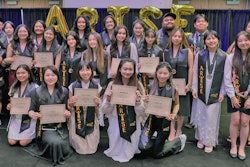The biggest diversity case in 2018, may well be the biggest one in 2019.
The Harvard case, in which Asian Americans sued Harvard for discrimination, could determine access to higher education for all people of color for decades to come. It also easily defines where Asian Americans stand on diversity. And just who the good guys are, isn’t exactly clear at first.
Do we back the aggrieved Asian students, our kids, as some prominent pro-Asian groups advocate? Tiger Moms and their kids with the perfect scores who didn’t get in — we’re for them, right?
Well, not so fast.
The trial in Boston came down to a battle of statistical models, with expert witnesses tweaking the numbers to prove their perspective.
 Emil Guillermo
Emil GuillermoBut let’s go with the kids who took the stand. And notice who didn’t.
Ed Blum’s group, Students for Fair Admissions — the anti-Harvard, anti-diversity, anti-affirmative action side led by White conservatives who claimed Asian American students were discriminated against — sent zero students to the witness stand.
None.
Maybe they were too busy with midterms at their second and third choice schools like another Ivy League or UC Berkeley, the places they wound up after being rejected from Harvard.
So for me, the real difference in this case are the Harvard students, past and present, who bravely testified under oath.
African-American, Latino, as well as Asian American students and alums spoke of the power of diversity and the holistic admissions policy at Harvard.
The most important student may have been Sally Chen. She was one of those less than perfect Asian Americans.
And we both had a lot in common.
We were both from San Francisco, from a family where the father was a cook in a restaurant and the mother was a homemaker. We were working class, not “poor.” But not rich. Both of us went to the same all-academic magnet school, Lowell High. And we both didn’t have the best SATs and GPAs.
What we had was a story. We overcame our parents’ immigrant past. And we both got into Harvard.
Chen testified that if Harvard couldn’t consider race, she wouldn’t be at Harvard now. “There’s no way in which my flat numbers and resume could’ve gotten across how much of a whole person that I am,” Chen said.
But life’s more than test scores. Chen was a student leader in high school. A community advocate. Her application reviewer said she had a balanced approach to life. A sense of humor. She was a whole person.
Was the kid with the perfect scores better than Chen?
That’s a judgment call. But Harvard says race is just one factor. And this holistic approach has been upheld as constitutional, and has admitted freshman classes that are over 20 percent Asian in recent years.
The U.S. Asian population is around six percent. Hard to prove discrimination given that kind of admissions record.
Yet, Blum found his Asian victims, mostly Chinese Americans, who felt their top scores merited admission, and sued Harvard. They argued Harvard could be more than 40 percent Asian if some kind of illegal quota weren’t in play.
Who wins this case depends on how you define discrimination and whether you believe the highest score MUST win.
Maybe in college football bowl game.
A few years back, I called the battle over affirmative action our “civil war,” as it both threatens to define and tear apart our Asian American community. I first saw it happen in California when state legislators tried to restore affirmative action in college admissions in 2012 and a group of Asian Americans loudly protested.
But it also alienated Asian Americans from other beneficiaries of affirmative action, namely Blacks and Latinos.
It’s interesting how in the Harvard case, the students who testified came from all racial groups, and didn’t defend Harvard so much as it extolled the virtues of diversity and equal opportunity.
That’s how those who wore the blue Defend Diversity shirts defined the case.
But other Asian Americans may see it only as “my kid, my scores, my Harvard.”
That’s why where you stand in the Harvard case may do more to define where Asian American identity is in 2018 and beyond.
Do we stand for each other, all people of color? Or just for ourselves? Fortunately, recent polls suggest the vast majority of Asian Americans support affirmative action.
When it comes to civil rights, Harvard student Sally Chen likes to say, Asian Americans are #NotYourWedge.
We’ll see how that works out in 2019 as lawyers on both sides wait for the judges decision, and eventual appeals up the justice ladder. It should be a no-brainer. But not in a Trump America where the selfishness and intolerance has been the preferred answer to diversity.
Emil Guillermo is a veteran journalist and commentator. He writes on race issues for the Asian American Legal Defense and Education Fund. You can follow him on Twitter @emilamok



















